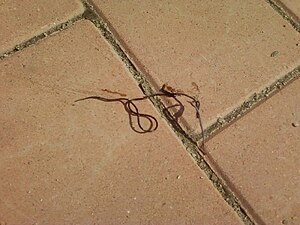Water calf
| Water calf | ||||||||||||
|---|---|---|---|---|---|---|---|---|---|---|---|---|

Gordius aquaticus |
||||||||||||
| Systematics | ||||||||||||
|
||||||||||||
| Scientific name | ||||||||||||
| Gordius aquaticus | ||||||||||||
| Linnaeus , 1758 |
The water veal ( Gordius aquaticus ) is a string worm - kind from the family of Gordiidae in the class of horsehair worms (Gordioida), as cosmopolitan in freshwater lives and insects parasitized . It is also " well wireworm called," but this is also a name for the externally very similar, phylogenetically but in no way related as well as anatomical and lifestyle ago completely different Brunnengräber worm .
features
The milky-white to brown water calf, speckled with yellowish-white round spots, is noticeably thin and long with only about 0.5 to 1 mm thick and a considerable length of 28 to 89 cm, which gives it a thread-like (filiform or nematomorphic) shape confers. The body surface is smooth and has a diamond pattern with slightly raised lines. The front end of the string worm is rounded and clearly thickened. In the male of the separate-sex water calf, the posterior end is bilobed and bent back on the underside, the two lobes being clearly hollowed out and copiously covered with papillae. Below the male's cloaca , the epidermis has a crescent-shaped fold. In the female, the rear end is cut perpendicular to the body axis. The female's cloaca is centrally located and is surrounded by a reddish-brown circle.
The external similarity of the water calf or other string worms with well worms such as the well burial worm has repeatedly led to these animals being confused with each other, with their organization and way of life being completely different. A string worm can be recognized under the magnifying glass by its missing bristles and ringlets, while there is a diamond pattern instead.
Like all string worms, the water calf has no mouth at all stages of life, but has a rudimentary intestine, the function of which has not yet been clarified. Food is only absorbed through the skin during the parasitic phase, while the adult animal no longer eats.
distribution and habitat
The water calf is widespread worldwide and is considered a cosmopolitan , but is only found as an adult animal due to its endoparasitic way of life. It attacks a wide variety of large insects such as grasshoppers, water beetles and dragonfly larvae.
Development cycle
Water calves are separate sexes and, when mating at the bottom of a body of water, wrap around each other in such a way that they form a tangle. The generic name Gordius goes back to this with reference to the Gordian knot . One female can produce up to 4 million eggs. The white, very yolk-rich, around 40 to 50 µm large eggs are laid in long chains. The female winds around the eggs, offering them protection and then dies. After about 4 weeks, small larvae hatch from the eggs with a proboscis with three hook rings and three stilettos at the tip. With the help of these, they penetrate the egg membrane and get into the open water, but then drill their way through the skin of aquatic insects or insect larvae under the action of proteases . To do this, the string worm larva everts its trunk 10 to 14 times per minute and then retracts it. The worm larva then lives in the body cavity, the mixocoel of the insect, and absorbs nutrients from the parasitized insect through its body surface. It grows into an adult string worm, losing its trunk. In some hosts with unfavorable living conditions, such as caddis fly larvae , the larva encapsulates itself and awakens to new life when the host has been eaten by a predatory insect such as a ground beetle and then continues to grow here. In some cases, the Gordius larvae encapsulate themselves on blades of grass in order to be eaten by locusts or other herbivorous insects. In this way, many larvae of the water calf get into land insects and grow here. After all, the now very long string worm can fill a large part of the insect's body. When the string worm is fully grown, it drills a hole in the insect's intersegmental or synovial membrane or its anus and leaves the host to live in the water. If the host is a land insect, the parasite is able to influence it in such a way that it visits the water. In many cases, the host dies after the string worm leaves it or it is sterilized by the parasite. This is followed by a phase of the water calf as an adult animal living freely in the water, which no longer consumes any food and finally seeks out a sexual partner in the water.
literature
- A. Villot: Gordius aquaticus . In: AS Packard Jr: Parasites of the Locust - The hair-worm parasite Gordius aquaticus Linn. In: FV Hayden (Ed.): Ninth annual report of United States Geological and Geographical Survey of the territories, embracing Colorado, parts of adjacent territories, being a report of progress of the exploration for the year 1875. US Government Printing Office, Washington DC 1877. pp. 662–667, species description on p. 666.
- Dieter Matthes: Animal Parasites: Biology and Ecology. Vieweg, Springer Fachmedien, Braunschweig / Wiesbaden 1988. Chapter Larval Parasitism - Die Rüssellarve der Saitenwürmer, pp. 221–223.
- JG Baer: Ecology of animal parasites. University of Illinois Press, Urbana, (Illinois) 1951.
Web links
- Sönke von den Berg (October 2006): Gordius aquaticus or the water calf.